Industrial Design Projects Fair 2021 was held online on June 2, 2021. You can watch the program on YouTube.
Companies and Projects:
| Arçelik | A+INF | ServiceKIT |
| DATABOSS | AGV- RL | ANODE |
| HAVELSAN | UWBSWARM | |
| KAREL | WIDENET | |
| REKROM | P-LIDAR | |
| ROKETSAN | CAESAR | ROBOCORS |
| SELVI TECHNOLOGY | AI4IMU | |
| SIGNALTON | IOTDSP | |
| SMARTICT | DD .CLOUD | |
| TAI | ARsembly | |
| UMRAM | MRI with SDR | |
| UNAM | DiagnosDisc |
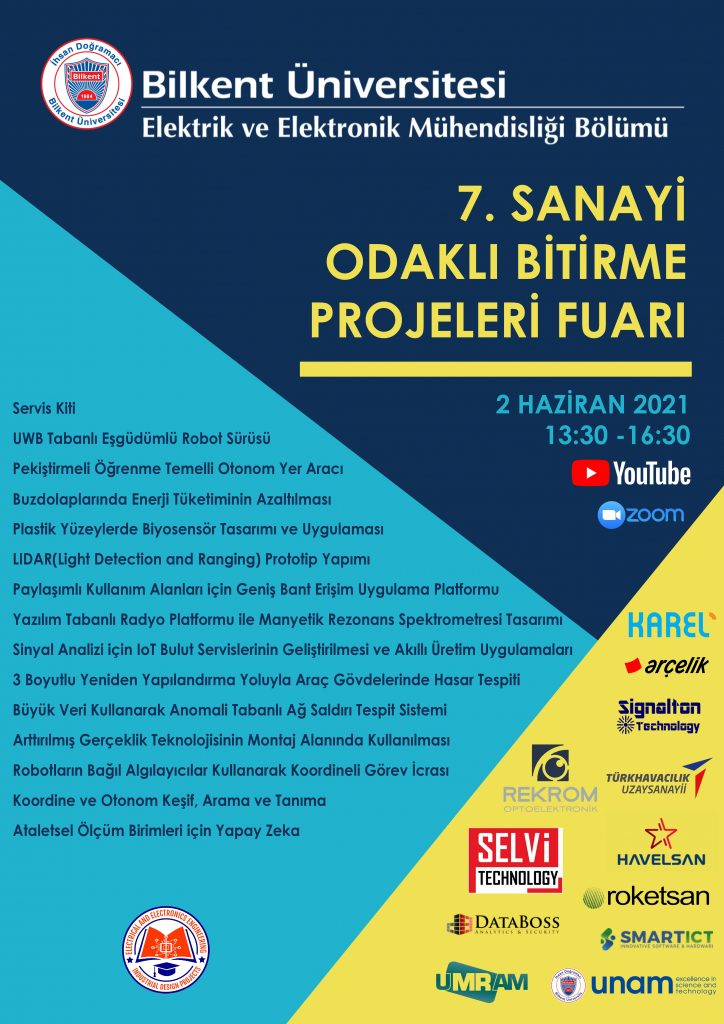
A1
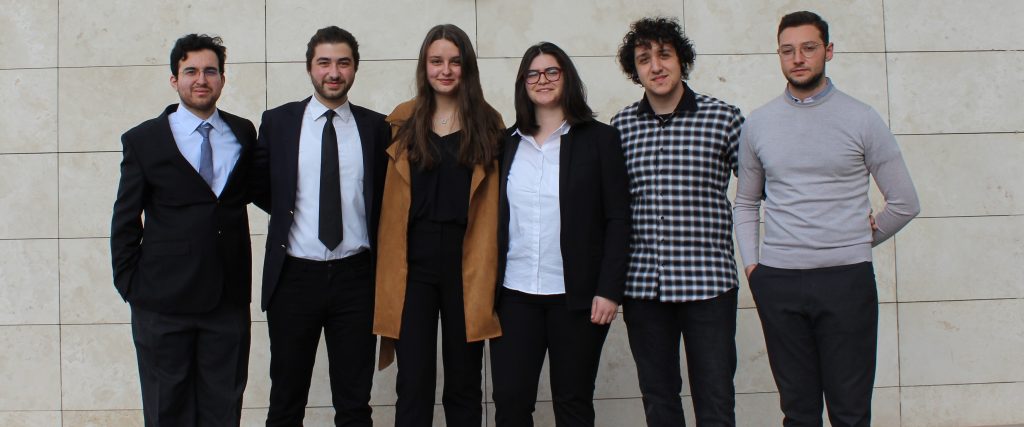
Project Name: Service Kit
Short Name: ServiceKIT
Company: Arçelik
Group Members: Mustafa Furkan Ayaz, Simay Başer, Beril Bayram, Utku Bilgin, İsmail İlter Sezan, Batu Şengezer
Service Kit project aims to design a portable kit that can detect and analyze various malfunctions for Arçelik refrigerators on the field and decrease the time for the repairment of faulty refrigerators. Service Kit aims to combine several functions regarding the repairment process, and an Android application is created to control the Service Kit. Service Kit is able to measure the instantaneous power consumption of the refrigerator, establish a serial connection between the refrigerator and the Service Kit, gather data from external sensors, classify malfunctions using Machine Learning algorithm and program and update the firmware of the electronic control card of the refrigerator through Cloud Service. The Service Kit includes a Raspberry Pi at the center of the kit. The external sensors and the power measurement circuit are directly connected to the Raspberry Pi. Raspberry Pi continuously communicates with the Cloud server where the Machine Learning algorithm runs, and the up-to-date firmware files are stored. A huge time and money-saving are expected with this kit with the ability of programming the electronic control cards on the field without requiring any additional modules and using solely Raspberry Pi. The Service Kit will prevent the unnecessary replacement of the electronic control card. This project is expected to be used in the field and decrease the maintenance expenses of Arçelik A.Ş. significantly.
A2

Project Name: REDUCING POWER CONSUMPTION OF REFRIGERATORS
Short Name: A+INF
Company: Arçelik
Group Members: Batu Altıparmak, Mehmet Emre Bozkurt, Latife Sezin İsmailoğlu, Selin Kaya, Zeynep Begüm Seven, Faruk Şükrü Türkuzan
Arçelik aims to decrease the power consumption of their products to prepare a better future for the environment with everyday household appliances that consume less energy with technological improvements. This project aims to achieve the minimum energy consumption in refrigerator lineup. The project was divided into two main branches, reducing the power consumption with hardware and software enhancements and modeling the refrigerator. As a result, both the mainboard and the refrigerator’s inverter card are reviewed, and after trials in both simulations and laboratory, possible improvements were found. The planned change proposals on the refrigerator’s inverter board are the buck converter circuit placement rather than the linear regulator, replacing the rectifier diodes, bara capacitors, and IGBTs with their alternative ones with less power loss. The project also aims to improve power consumption by addressing the software. Thus, the refrigerator’s digital model is constructed, which uses deep learning techniques such as Long Short Term Memory to predict its temperature sensors’ outputs and instantaneous power consumption concerning time. The model can also determine the refrigerator’s consumer’s opening of the fresh food compartment’s door. These behaviors can be used in the cooling algorithm of the refrigerator to improve its power consumption. This feat can be achieved by adjusting the refrigerator’s compressor frequency according to the model’s user behavior detection.
A3
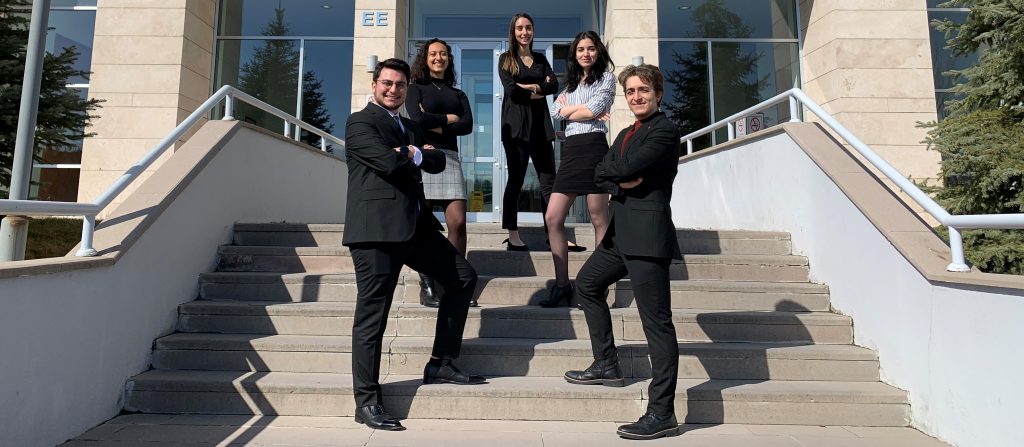
Project Name: ANOMALY-BASED NETWORK INTRUSION DETECTION SYSTEM USING BIG DATA
Short Name: ANODE
Company: DATABOSS SECURITY & ANALYTICS A. S.
Group Members: Beste Aydemir, Berfin Kavşut, Şevki Gavrem Kulkuloğlu, Ege Ozan Özyedek, Meltem Toprak
This project is an online anomaly detection system on single-source and multi-source streaming network traffic data. Different from signature-based intrusion detection systems, where the detection is based on pattern recognition of pre-stored anomalies, anomaly detection-based intrusion detection systems allow the system to find novel network attacks. In this project, anomaly-based attack detection is achieved in three steps: data acquisition from a network and interpretation of network data in terms of quantitative features, state-of-the-art anomaly detection algorithms, and the user interface. In the data acquisition phase, a large amount of network data packets are collected from multiple sources in the local network. These data packets are then interpreted and converted to meaningful features that can be used in detection algorithms. After the detection algorithms evaluate each packet, the results and alarms are provided to the user in a flexible and practical user interface. The network traffic data has approximately 100 events per second for each host. The best achieved results are that the Area Under Receiver Operating Characteristic curve is 0.61, F1-Score is 0.203, and Precision-Recall curve is above no skill line.
A4
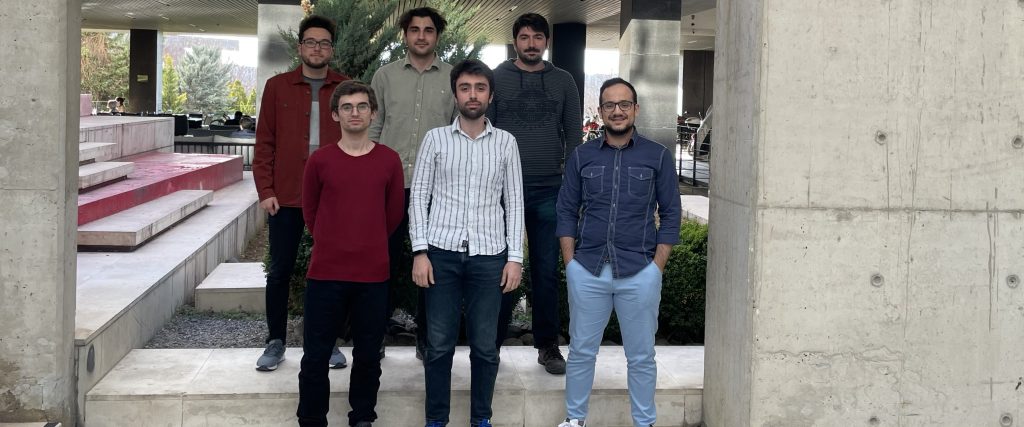
Project Name: AUTONOMOUS GROUND ROBOT (VEHICLE) BASED ON REINFORCEMENT LEARNING (RL)
Short Name: AGV- RL
Company: DATABOSS SECURITY & ANALYTICS A. S.
Group Members: Altan Akat, Enes Duran, Ahmet Kağan Kaya, Furkan Burak Mutlu, Nurullah Sevim, Samed Alperen Tavşancı
Autonomous driving with Reinforcement Learning is one of the emerging technologies and Databoss is one of the companies working on this field. The main objective of this project which is conducted with Databoss is to provide autonomous driving to a model vehicle using Reinforcement Learning algorithms. Initially, restrictions of a 1:10 scaled model vehicle, which is specifically designed for autonomous driving, and sensor behaviours of LIDAR (Light Detection and Ranging), ZED (stereo depth camera) and IMU (Inertial Measurement Unit) are modelled at Unreal simulation environment. Then, output of the sensors are fed to the Reinforcement Learning algorithms to provide location of the vehicle, location of the target and distance to the nearby objects in simulation. Algorithms are designed to decide the next action when these information are provided. Then, punishment is given to the vehicle in the case of crash or reward is given to the vehicle in the case of successful arrival to the target location depending on the next action. Trained models using algorithms are tested and successful models are saved. Then, these models are loaded into the model vehicle and autonomous driving in the real-world environment is accomplished.
A5
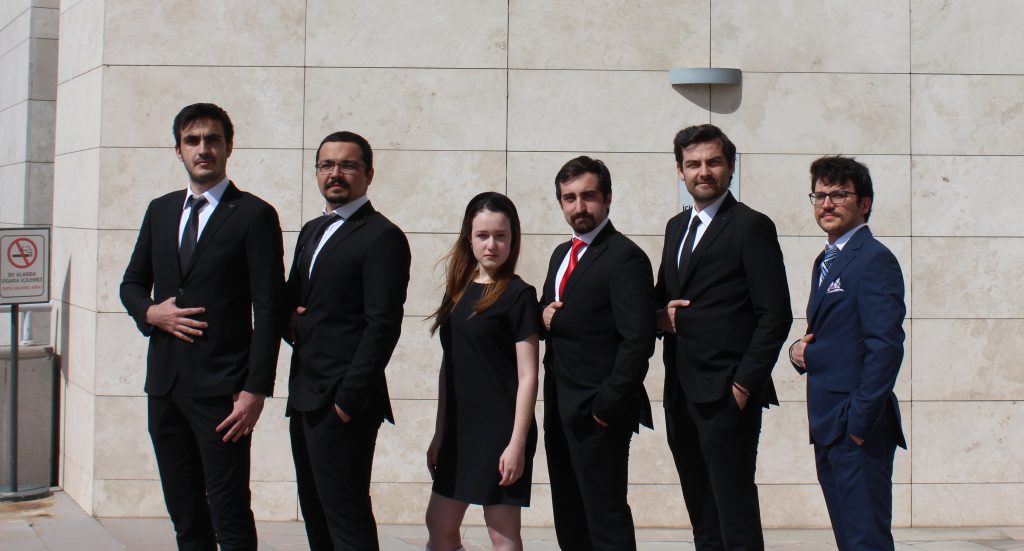
Project Name: UWB BASED MULTI-ROBOT COORDINATION
Short Name: UWBSWARM
Company: HAVELSAN
Group Members: Erkan Bayram, Kemal Alperen Çetiner, Ceren Erkut, Baran Kırdar, Özenç Uğur, Atakan Yiğit
The project aims to design a swarm robotics system of three robots moving in coordination along a specific route. The design will be independent of the initial position of the robots. During the movement, the robots are expected to acquire the relative direction and distance with respect to each other and the desired behavior will emerge from the interactions between them. Each robot will be equipped with an IMU module, a Wi-Fi module and a UWB kit. Two of the robots will follow the other one, the leader robot. The leader’s movement will be controlled with the data acquired from the user application via an MQTT connection. The acquisition of direction and angle data will be realized based on the angle of arrival (AoA) concept. For AoA, we will use a UWB kit that employs the phase difference of arrival (PDoA) method using two built-in antennae. The simulations will be performed based on the most essential parts: position controller for the proper movement of robots and understanding the PDoA concept to see the possible errors in AoA. MATLAB and Python will be used for simulations. The hardware and software will be tested using the robots. During the operation of the system, unpredictable and undesirable signals in the environment may cause noise and errors. To remedy this, Kalman filters will be used. In the end, the robots are expected to preserve their initial formation and distance throughout the operation with at most 15 cm error.
A6
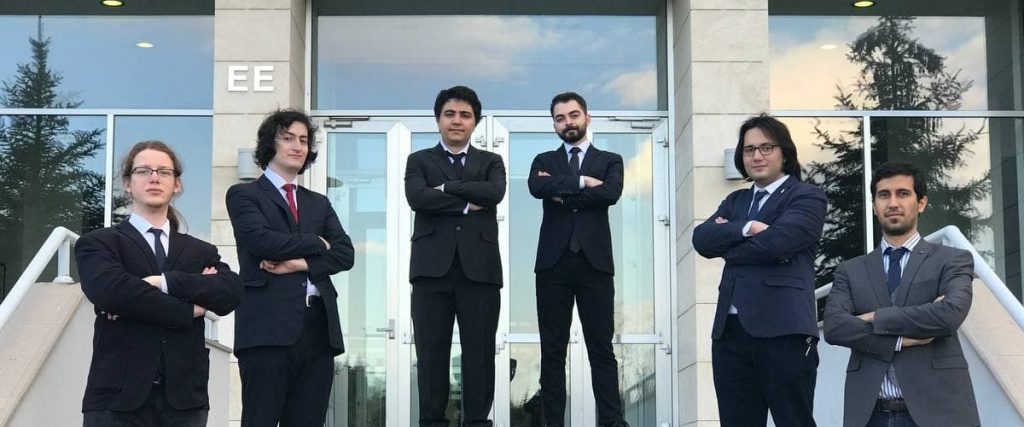
Project Name: BIOSENSOR DESIGN AND APPLICATION UTILIZING DVDS
Short Name: DiagnosDisc
Company: NATIONAL NANOTECHNOLOGY RESEARCH CENTER – UNAM
Group Members: Emre Acartürk, Ege Balcıoğlu, Ekin Bircan Boşdurmaz, Ozan Kırdar, Amirhossein Maghsoudi, Hüseyin Caner Oflaz
The current biosensors in the market are either working exclusively in lab environments or they are not quantitative enough for the end-users. This means that there are no accessible devices that can be used by anyone on the point-of-care level. This project aims to design a plasmonic biosensor that detects the analyte concentration changes quantitatively by tracking the deviations seen in the incident light’s reflected signal to the surface and solution. With Lumerical simulations, we compare our own results with the results that appear in the literature. Based on this comparison, we design and manufacture the chip. Along with the 3D design we manufacture, we come up with the overall product that will prevent the patients going to a hospital or a clinic because the sensor will be usable in point-of-care applications by only the patient. Thus, the end product price is a limiting factor that will be solved by reusing waste DVDs. Since the biosensor is a device that should be sanitary, a cartridge design will be implemented where solutions of analytes are placed on these small chips. These chips are made by utilizing the grating structure on the surface of DVDs. Also, a portable analysis unit and a user-friendly graphical user interface are additional features of this sensor.
A7
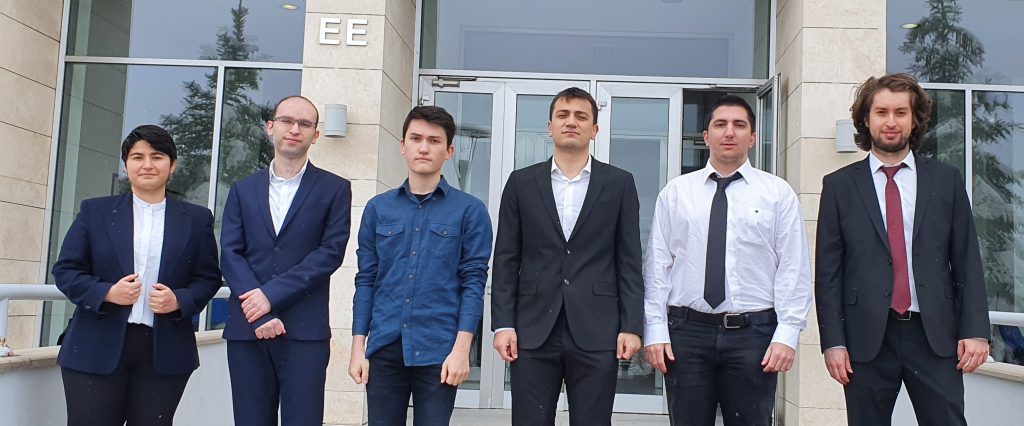
Project Name: LIDAR (Light Detection and Ranging) Prototype
Short Name: P-LIDAR
Company: REKROM OPTOELEKTRONİK MÜHENDİSLİK SİSTEM TEKNOLOJİLERİ LTD. ŞTİ.
Group Members: Bengisu Akyürek, Saltuk Buğrahan Çelik, Batuhan Berkay Giziroğlu, Emre Orta, Barış Bilgin Şenol, Fatih Zeybek
The goal of the LIDAR (Light Detection and Ranging) Prototype Design project is to develop a LIDAR prototype to be used in automotive systems such as self driving cars. LIDAR systems are used for measuring the distance between the target and the system using the time of flight of a laser signal sent to the target which reflects back to the system. The three main modules (a transmitter for laser pulses, a receiver for laser pulses and a control and processing module) that make up a LIDAR system will be designed and developed in the course of the project. The project also aims to include cloud mapping of the data gathered from the transceiver. The transmitter and the receiver modules are controlled by a microprocessor. The distance calculation is performed by measuring the time difference between the laser pulse being transmitted and the receiver module triggering the Time-to-Digital Converter. The distance data will be processed and used to obtain cloud mapping.
B1
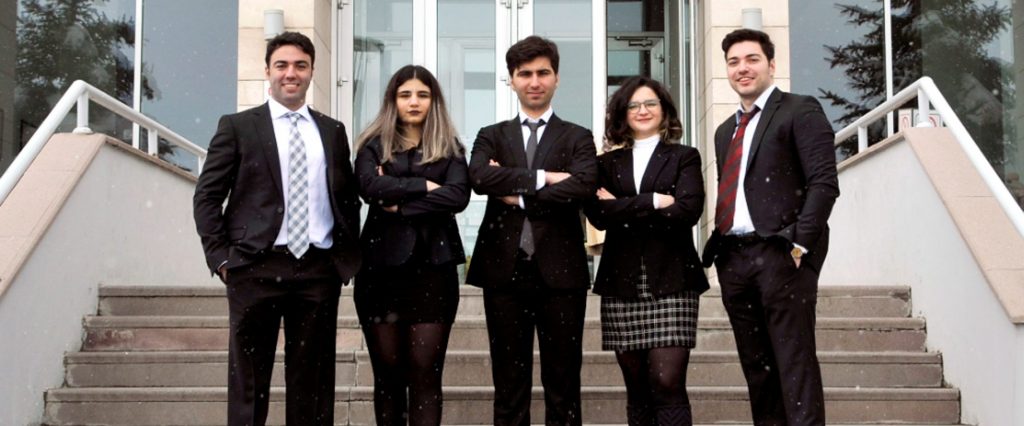
Project Name: WIDE BAND ACCESS APPLICATION FOR SHARED USAGE AREAS PLATFORM
Short Name: WIDENET
Company: KAREL ELECTRONICS
Group Members: Zelal İrem Aldağ, Can Çetindağ, Cengizhan Kaya, Evrim Mete, Berkan Özdamar
The primary purpose of the project is to develop aWide Band Access Application for shared usage areas. In this project, 5G signal is used as a source of the Internet. Using Quectel Evaluation Board as the main gateway, a 5G radio base station signal is transformed into the WiFi 6 signal used as a local shared network in the building. The project’s network topology is designed over the Edge-Core router switch provided by ULAK and all access points. To build the network, Software Defined Networking method with ONOS controller is used. As control plane decoupling, the project uses OpenFlow. Since providing Internet to all shared usage areas may decrease the QoS in a complex building, this project aims to deploy smart traffic routing and flow prioritization algorithms for intent-based networking that use traffic parameters and human density. Human density is estimated by collecting data from the sensor module placed around each access point, including a microphone, 3-axis accelerometer, air-quality, temperature sensors, and receive signal strength indicator. While the network traffic parameter provides information related to network usage, the human density estimation offers insights related to possible crowdedness in the system over access points. A Long-Short Term Memory (LSTM) model, previously trained with a custom dataset, estimates human density. The system prioritizes this network flow and stabilizes QoS all over the building. To simulate and test the project, the Mininet Network Emulator program is used with ONOS source code, IntelliJ IDEA, and Bazelisk.
B2
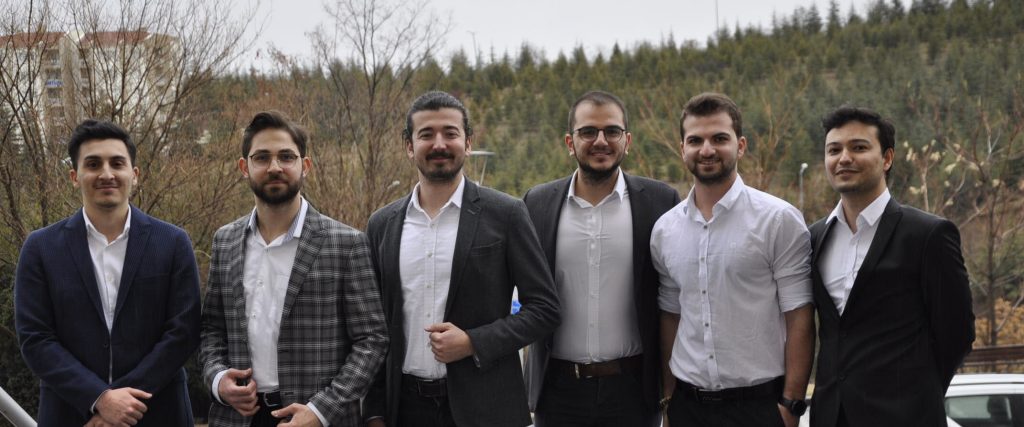
Project Name: DAMAGE DETECTION ON CAR BODIES THROUGH 3D RECONSTRUCTION
Short Name: DD .CLOUD
Company: SMARTICT
Group Members: Cem Daloğlu, Kenan Korhan Odabaş, Ahmet Faruk Saz, Ömer Altuğ Sevimay, Cem Okan Yaldız, Furkan Yılmaz
The main motive of the project is to autonomously detect damages on car bodies based on depth information. The investigated approach relies on Intel Real Sense D435 RGB-Depth cameras [6] that use stereo-vision and IR projectors to extract 3D point cloud data. To the best of our knowledge, there is no similar system in the world that uses RGB-Depth cameras for depth based damage detection. The system extracts point cloud data and creates a 3D model of a car twice to compare them later for detecting damages. For each model created at different times, point cloud data coming from different cameras are registered through specific algorithms. Since the data is noisy, several filters and denoising algorithms are utilized in the system. The two models constructed at the entrance and at the exit of the target platform are compared and damages are detected if the difference at particular spots are above a threshold. Furthermore, considering the computational needs of the damage detection system, a custom PCB is designed to allow the commercialization of a new microcontroller unit.
B3
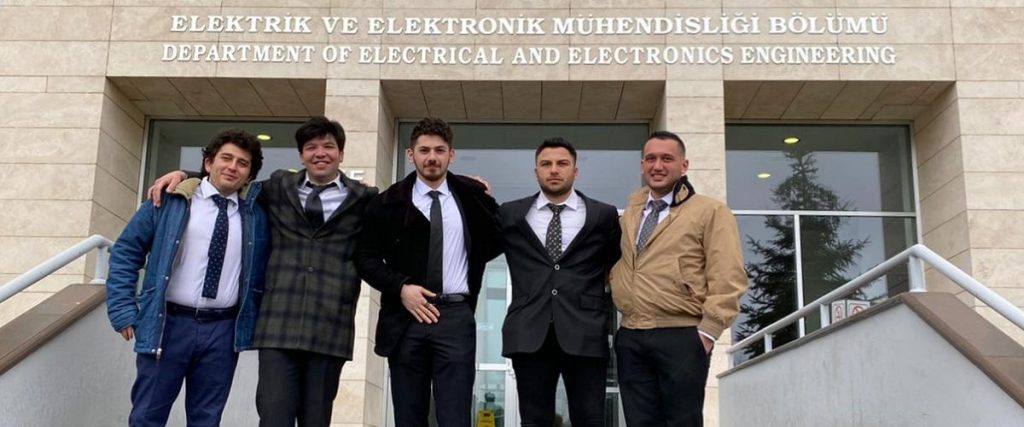
Project Name: Augmented Reality Solutions in Assembly Processes
Short Name: ARsembly
Company: TURKISH AEROSPACE INDUSTRIES – TUSAŞ
Group Members: Cemal Güven Adal, Arman Vural Budunoğlu, Eksal Uras Kargı, Can Kocagil, Ahmet Ali Nuhoğlu
During the assembly process of the products in Turkish Aerospace Industries (TAI), wrong attempts on assembling small components into the main component make small components defective and unable to be used again. Our main approach to solving this problem is taking the advantage of the augmented reality for creating an experience-independent assembly process for operators. A mobile application is developed based on augmented reality, and it is planned to guide the assembly operator by overlaying computer-generated images (CGI) on top of the real-time captured video throughout assembly processes assembly-related data. The user information will be stored in an external database that will be capable of holding users’ last step in the assembly process. Required data will be transferred to the mobile application after users’ login. Our project is granted ”TUBITAK 2209-A – Üniversite Öğrenciler Araştırma Projeleri Destekleme Programı”.
B4
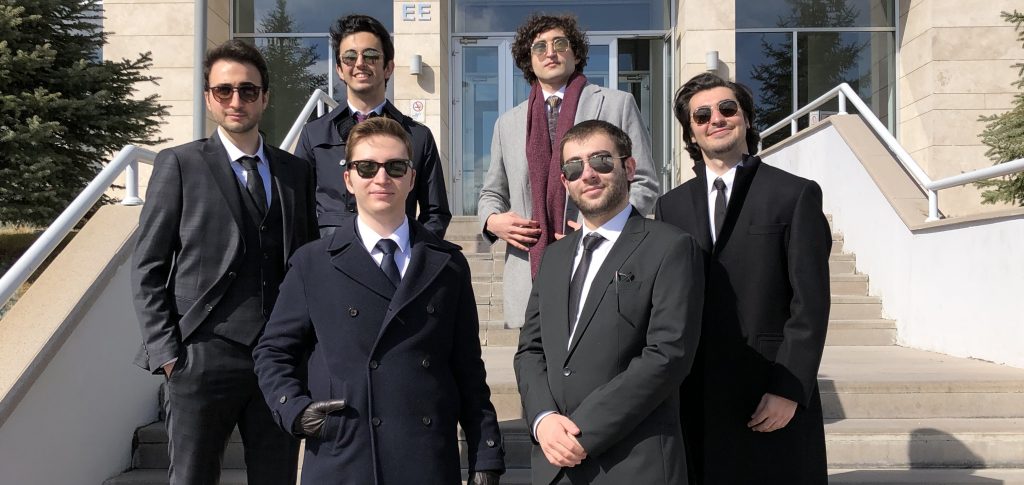
Project Name: COORDINATED TASK EXECUTION OF ROBOTS USING RELATIVE SENSORS
Short Name: ROBOCORS
Company: ROKETSAN
Group Members: Tuna Alikaşifoğlu, Yüksel Arslantaş, Adil Berkay Temiz, Yiğit Berk Üçüncü, Berk Yaşar Yavuz, Atahan Yorgancı
In this project the aim is to develop autonomous mobile robots with different configurations that can collectively perform common objectives by identifying other robot’s states without RF communication between robots. Common objectives will be executed with three different robot hardware structures configuration to satisfy the heterogeneous robot requirement. In order to create a system without RF communication, robots will make use of both LIDAR and camera sensors to construct visual representation for their environments. The robot’s ability to execute common objectives will be evaluated using five different scenarios. If the developed system is able to complete all five scenarios, the project can be deemed successful. These scenarios are “Target Identification and Transition with One Robot”, “Pioneer Robot Following”, “Target Identification and Locating with Three Robots”, “Target Identification and Transition with Three Robots While Avoiding Obstacles” and “Hostile Target Detection and Avoiding”. Target, and peer identification is required for all of the scenarios, and identification will be achieved by processing image data acquired from LIDAR and camera. Path finding problems in scenarios will be solved with grid based, and potential field based algorithms. Developed algorithms will be deployed to robots using Redis for lightweight multitasking, and inter-process communication. The development process will follow the regression testing method by using computer simulation environments. After compilation of the testing steps, verified simulation projects will be transferred to the hardware part.
B5
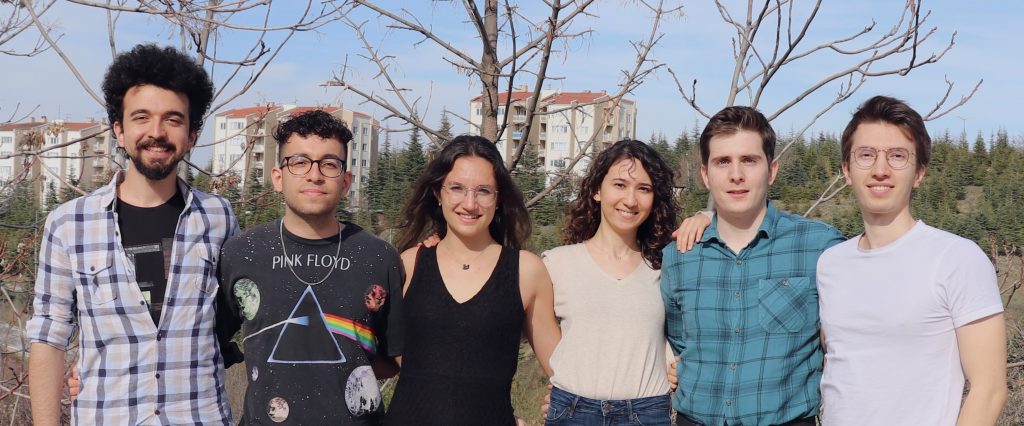
Project Name: COORDINATED AND AUTONOMOUS EXPLORATION, SEARCH, AND RECOGNITION
Short Name: CAESAR
Company: ROKETSAN
Group Members: Cafer Mertcan Akçay, Yusuf Umut Çiftci, Su Direkci, Yiğit Efe Erginbaş, Özgür Bora Gevrek, İrem Kaftan
With the increasing advantages of autonomous vehicles in warfare, stakeholders of the defense industry, such as Roketsan, are exploring the future territory with various research and development projects. Accordingly, our project aims to construct an autonomous system that can navigate an unknown location and locate a predetermined target. For this purpose, we use a stereo camera, a LIDAR, and an INS. By analyzing the data stream obtained from these sensors, the robot will decide its next maneuver and map its surroundings. To achieve this, we have designed and implemented numerous work tasks, such as temporal and spatial calibration between the sensors, point cloud fusion, SLAM algorithms, segmentation, scene matching, target localization, building the robot, and motion planning. We implemented them using the ROS framework with C++ language. Our end goal and criteria for success are to realize a scenario where the robot explores its environment autonomously and locates the target.
B6
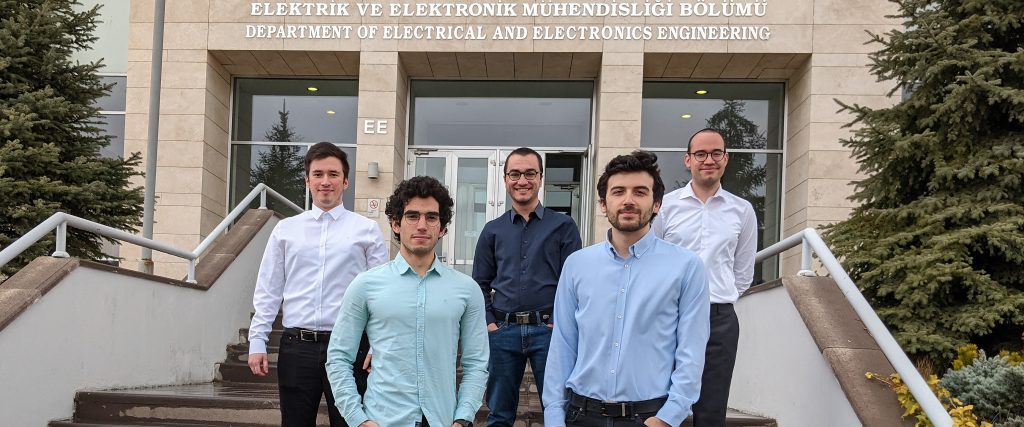
Project Name: ARTIFICIAL INTELLIGENCE FOR IMU
Short Name: AI4IMU
Company: SELVI TECHNOLOGY
Group Members: Vagif Abdulla, Berk Bozkurt, Tolga Dimlioğlu, Sepehr Elahi, Arda Güçlü
An inertial measurement unit (IMU) is a crucial device used in drones that measures linear acceleration and angular velocity, helping predict the drone’s position and orientation. However, the predictions are often inaccurate and noisy due to the needed double and single integration for calculating position and orientation from acceleration and angular velocity readings, respectively. In this project, we designed, tested, and ultimately developed deep learning-based methods for increasing the accuracy of the predictions. More specifically, we implemented a publicly available angular velocity denoising model for orientation prediction, combined with our own convolutional neural network-based model for position prediction in PyTorch. We trained and tested our model on two publicly available datasets, EuRoC and TUMVI, which comprise pairs of IMU readings and position plus orientation ground-truths, achieving better results than raw integration alone. Furthermore, we deployed our model on an Nvidia Jetson Nano that is connected to a BMI160 IMU, optimizing it to make predictions at rates higher than 4 kHz.
B7
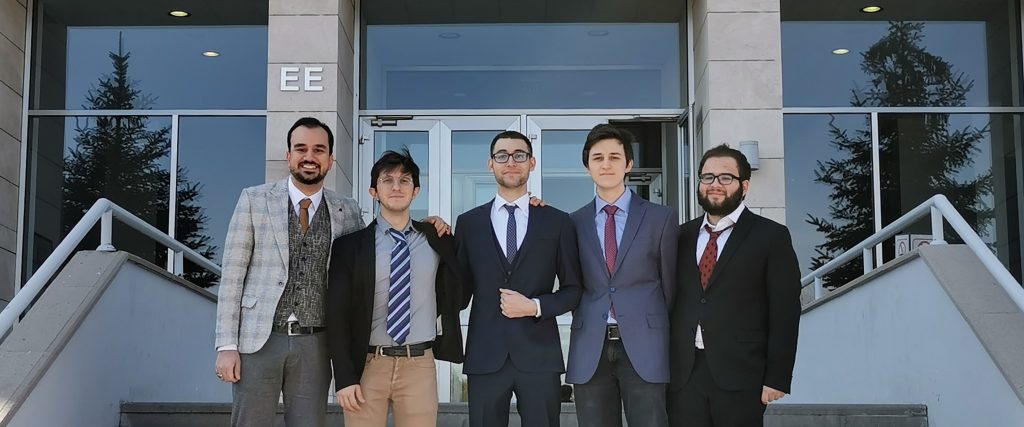
Project Name: DEVELOPMENT OF IOT CLOUD SERVICES FOR SIGNAL ANALYSIS WITH APPLICATION TO SMART SYSTEMS
Short Name: IOTDSP
Company: SIGNALTON
Group Members: Arda Buğlagil, Mert Ertuğrul, Mehmet Ömer Eyi, Can Kınık, Çağan Önen
The main goal of this project is to develop IoT cloud services for signal analysis with application to smart systems, in particular to smart manufacturing. It introduces several functionalities, including object tracking, 3D position finding through a stereo camera setup, social distancing violation tracking, prohibited area detection, face recognition, PPE detection, acceleration monitoring and noise level analysis. The solution strategies we offer are keeping track of the position of workers inside an indoors environment, checking the PPE and identity of workers at the gates to regulate entrance, detecting fall related injuries or dangerous noise levels for ensuring worker safety, reporting the location of demanded objects/tools to increase time efficiency, and predicting which machines may malfunction and require attention. In the end, we were able to achieve all of the mentioned solutions with sufficient accuracy in our simulated conditions.
B8
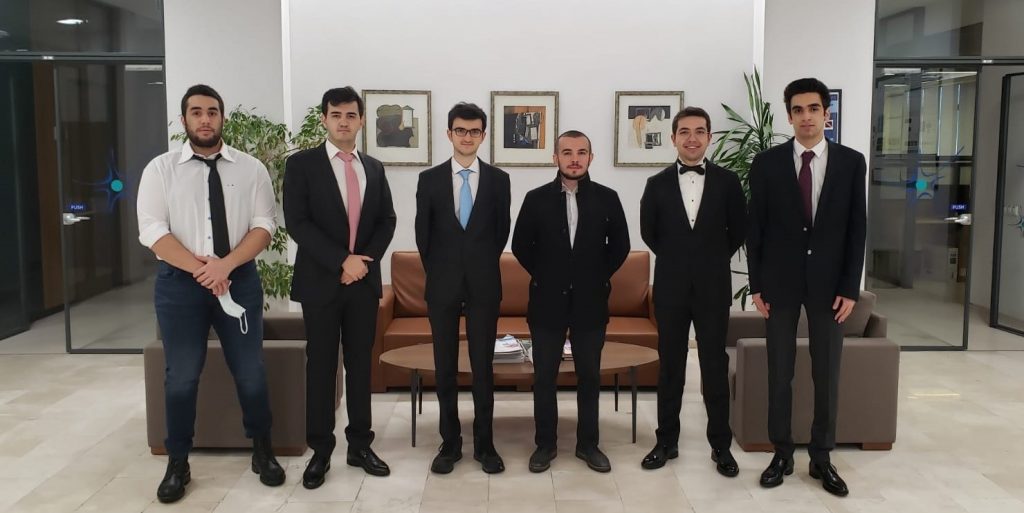
Project Name: MAGNETIC RESONANCE IMAGING DIGITAL SPECTROMETER DESIGN WITH SOFTWARE-DEFINED RADIO PLATFORM
Short Name: MRI with SDR
Company: UMRAM
Group Members: Arda Can Aras, Abdullah Arda Aşcı, Alperen Fedakar, Alp Emre Şahin, Uğur Yılmaz, Yaman Yücel
The aim of the project is to redesign the RF receive chain. Different from traditional MRI machine, a software defined radio board (SDR) is used for this purpose. There is not such application in Turkey recently. The working principle; firstly, signal generator generates a pulse-modulated sine wave which has a carrier frequency that is equal to the resonance frequency of the hydrogen atom. Then the receiver side of the LimeSDR collects the reflected data from the coil. This data consists of a free induction decay (FID) signal which contains the essential imaging data after processing. Ultra-low noise amplifier will amplify the signal to be demodulated noise-free. The receiver part performs IQ demodulation. Then, the signal will be oversampled with the analog to digital converter (ADC). The data obtained from the ADC will be decimated to obtain original data formed by the MRI machine. The data is collected through the usage of the trigger signal of the MRI machine. At last, inverse discrete Fourier transform will be taken in the MATLAB environment to get image data. LimeSDR board is connected to the MRI device and signal generators via u.FL to SMA and u.FL to BNC connectors. To validate our design, the system should work regardless of time, also we should receive the data produced by the coil. Using a LimeSDR board brings a cheaper and more adaptable solution to MRI signal reception and generation.